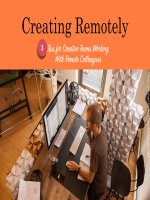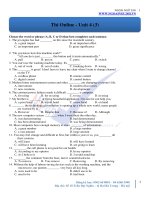4 3 3 day for night
Bạn đang xem bản rút gọn của tài liệu. Xem và tải ngay bản đầy đủ của tài liệu tại đây (2.48 MB, 10 trang )
Suggested levels for Guided Reading, DRA,™
Lexile,® and Reading Recovery™ are provided
in the Pearson Scott Foresman Leveling Guide.
Earth Science
Day for
Night
Genre
Narrative
nonfiction
Comprehension
Skills and Strategy
• Generalize
• Cause and Effect
• Visualize
Text Features
•
•
•
•
Captions
Diagrams
Labels
Glossary
Scott Foresman Reading Street 4.3.3
ISBN 0-328-13448-1
ì<(sk$m)=bde ij< +^-Ä-U-Ä-U
by Kirsten Anderson
Reader Response
Day for
Night
1. What generalizations can you make about
diurnal and nocturnal creatures? Write one
generalization for each type.
2. Reread pages 10 and 11. Make a web with Earth’s
Orbit in the center. Around it write words from
the book that help you visualize Earth on its axis
in orbit.
Earth’s
Orbit
3. What might you be writing about if you used the
words gleamed and shimmering? Use each in a
sentence.
4. How does the diagram on pages 10 and 11 help
you understand Earth’s path around the sun?
by Kirsten Anderson
Editorial Offices: Glenview, Illinois • Parsippany, New Jersey • New York, New York
Sales Offices: Needham, Massachusetts • Duluth, Georgia • Glenview, Illinois
Coppell, Texas • Ontario, California • Mesa, Arizona
CONTENTS
CHAPTER 1
Sun, Moon, and Stars
4
CHAPTER 2
Center of the Universe
6
CHAPTER 3
Light and Dark
10
CHAPTER 4
They Live by Night
Glossary
13
16
Every effort has been made to secure permission and provide appropriate credit for
photographic material. The publisher deeply regrets any omission and pledges to
correct errors called to its attention in subsequent editions.
Unless otherwise acknowledged, all photographs are the property of Scott Foresman,
a division of Pearson Education.
Photo locators denoted as follows: Top (T), Center (C), Bottom (B), Left (L), Right (R),
Background (Bkgd)
Opener: Tom Walker/Getty Images; 4 David Lissy/Stock Connection; 5 Peter Arnold,
Inc.; 6 Photo Researchers, Inc.; 6 Photo Researchers, Inc.; 7 Corbis; 8 Detlev van
Ravensway/Photo Researchers, Inc.; 10 Mark Garlick/Photo Researchers, Inc.; 13 S.J.
Krasemann/Peter Arnold, Inc.; 14 Mark L. Stephenson/Corbis; 15 Chase Swift/Corbis
ISBN: 0-328-13448-1
Copyright © Pearson Education, Inc.
All Rights Reserved. Printed in the United States of America. This publication is
protected by Copyright, and permission should be obtained from the publisher
prior to any prohibited reproduction, storage in a retrieval system, or transmission
in any form by any means, electronic, mechanical, photocopying, recording, or
likewise. For information regarding permission(s), write to: Permissions Department,
Scott Foresman, 1900 East Lake Avenue, Glenview, Illinois 60025.
2 3 4 5 6 7 8 9 10 V0G1 14 13 12 11 10 09 08 07 06 05
3
Chapter 1 Sun, Moon, and Stars
Suppose you are on a camping trip. You have been
hiking all day and now it is night. After a long day’s
journey, you set up camp and sit in front of a campfire.
The heat warms your face. The brilliant colors of the
flames light up the area in front of you.
Now turn around. Your back is to the fire. Your face
is cold. The world in front of you is dark. You were able
to turn your world from day to night. You look up at
the stars. How does the sky turn from day to night?
Thousands of years ago, people also looked up at
the sky. They watched the movement of the sun. They
saw the moon. Small planets gleamed in the distance.
Shimmering stars faded in the dawn. People wondered
how the universe worked.
At night the moon seems to shine.
4
5
Chapter 2 Center of the Universe
It was A.D. 150. Ptolemy was a Greek astronomer,
or someone who studied objects and matter in outer
space. He thought Earth was at the center of a giant
circle. The sun, moon, stars, and other planets were all
set in the circle. They traveled around the circle. Most
people agreed with Ptolemy’s ideas about Earth being
the center of the universe.
Nicolaus Copernicus was a Polish astronomer in the
early 1500s. He was asked to help make a new calendar.
It needed to match days with the movements of the sun
and moon.
Copernicus began to think Ptolemy was wrong. The
movement of the planets didn’t seem right. Copernicus
imagined another universe.
Ptolemy thought that
objects in space moved
at the same speed
and at the same time
around Earth.
Copernicus did not agree with Ptolemy.
6
7
Copernicus pictured the sun at the center of the
universe. The planets moved around the sun. They
traveled at different speeds. This made more sense to
Copernicus.
It took a long time for people to accept Copernicus’s
ideas. In the 1600s the German astronomer Johannes
Kepler wrote about the planets and their movements.
He agreed with Copernicus. Galileo, a scientist from
Italy, used a telescope to prove Copernicus was right.
Powerful people became angry. They wanted Galileo
to say Copernicus was wrong. Galileo believed he was
right and did not want to be a coward. He refused and
was banned from publishing his writings.
Copernicus, Kepler, and Galileo were right. By
the end of the 1600s, most people believed that Earth
moved around the sun.
Earth’s place in the universe helps explain a lot
about day and night. It helps us understand why some
days are longer than others.
The sun is the center of the solar system.
8
9
Chapter 3 Light and Dark
Earth follows a path around the sun. The path is
called an orbit. The orbit is oval-shaped. Earth takes
about 365 days, or one year, to move around the sun.
Earth spins on its axis at the same time that it travels
around the sun. The axis is an imaginary line that runs
through Earth.
Earth’s Orbit
Earth spins on its axis like a top. It takes
twenty-four hours to make one complete turn. During
this turn, each part of Earth faces the sun, making the
day. After turning away from the sun, it is night. Day
and night make one cycle.
The axis tilts on an angle. It keeps Earth on a tilt.
This means that, during the orbit, the North Pole and
the South Pole are each tilted toward the sun for half of
the orbit.
Earth
Earth
Axis
Earth
Axis
Sun
Earth
Axis
Axis
10
Earth is always tilted at
the same angle on its
axis as it travels around
the sun.
11
At the top of Earth are the North Pole and the Arctic
Circle. At the bottom of Earth are the South Pole and
Antarctica. The tilt means that for six months, or during
half of Earth’s orbit around the sun, one pole always
has some light. At that pole, daylight lasts longer and
longer as Earth travels around the sun. This is because
the pole is tilted toward the sun.
Finally, there is a point where the sun’s rays directly
hit the pole. Then that pole has days of complete
sunlight. At the same time, the other pole has days of
complete darkness. Earth keeps moving in its orbit. Six
months pass. Then the other pole faces the sun. It too
will have full days of sunlight.
Chapter 4 They Live By Night
Now suppose you’re back at your campfire. At night,
the trees, rocks, and grass are the same as they were
during the day. But at night there are new sounds. You
hear a chorus of crickets chirp. Bats fly in the dark sky.
The animal world has changed.
Bats take to the night sky.
The sun never sets on this day in the Arctic Circle.
12
13
Mammals, reptiles, and insects have patterns to their
lives. Some live their lives during the day. They wake
up as the sun rises. They feel hungry when it is light.
They are active. When it gets dark, they become sleepy.
These are diurnal creatures. Horses, dogs, lizards, and
butterflies are some diurnal creatures.
Nocturnal means “to live by night.” Nocturnal
creatures sleep during the day. At night they come
out and look for food. Bats, owls, moths, hamsters,
raccoons, and tree frogs are all nocturnal creatures.
Why are some species nocturnal? Long ago small
animals and reptiles hid during the day to avoid
predators. At night there was less competition for them
to find food.
Others responded to the climate. Desert creatures
hid during the hot day. They came out for food during
cool nights. As a result, nocturnal creatures became
adapted for night. Some have eyes that are made for
darkness. Others, such as bats and rodents, use their
senses of hearing and smell to help them in the dark.
You are back at your campfire. It’s dark. Your place
on Earth has turned away from the sun. But Earth
keeps spinning on its axis. It will take you back to the
day. This is the cycle of Earth.
The raccoon is a nocturnal creature.
14
15
Glossary
Reader Response
brilliant adj. shining
brightly; sparkling.
gleamed v. flashed or
beamed with light.
chorus n. anything
spoken or sung at the
same time.
shimmering adj.
gleaming faintly.
coward n. a person
or animal that lacks
courage or is easily
made afraid.
1. What generalizations can you make about
diurnal and nocturnal creatures? Write one
generalization for each type.
2. Reread pages 10 and 11. Make a web with Earth’s
Orbit in the center. Around it write words from
the book that help you visualize Earth on its axis
in orbit.
Earth’s
Orbit
3. What might you be writing about if you used the
words gleamed and shimmering? Use each in a
sentence.
4. How does the diagram on pages 10 and 11 help
you understand Earth’s path around the sun?
16









